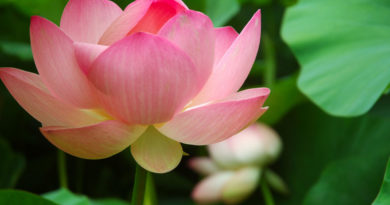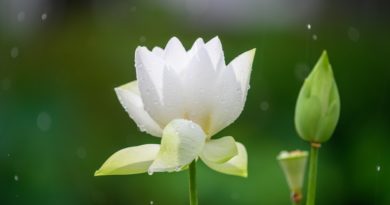Going For Refuge & Taking The Precepts – Vi. The Methods Of Going For Refuge – Bhikkhu Bodhi
VI. THE METHODS OF GOING FOR REFUGE
The methods of going for refuge divide into two general kinds: the superior or supramundane going for refuge and the common or mundane going for refuge. The supramundane going for refuge is the going for refuge of a superior person, that is, of an ariyan disciple who has reached the supramundane path leading irreversibly to nibbana. When such a person goes for refuge to the Triple Gem, his going for refuge is a superior refuge, unshakable and invincible. The ariyan person can never again, through the remainder of his future births (which amount to a maximum of only seven), go for refuge to any other teacher than the Buddha, to any other doctrine than the Dhamma, or to any other spiritual community than the Sangha. The Buddha says that the confidence such a disciple places in the Triple Gem cannot be shaken by anyone in the world, that it is firmly grounded and immovable.
The common way of going for refuges is the way in which ordinary persons, the vast majority below the ariyan plane, go for refuge to the Triple Gem. This can be subdivided into two types: the initial going for refuge and the recurrent going for refuge.
The initial going for refuge is the act of formally going for refuge for the first time. When a person has studied the basic principles of the Buddha’s teaching, undertaken some of its practices, and become convinced of its value for his life, he may want to commit himself to the teaching by making an outer profession of his conviction. Strictly speaking, as soon as there arises in his mind an act of consciousness which takes the Buddha, Dhamma, and Sangha as his guiding ideal, that person has gone for refuge to the Triple Gem and become a Buddhist lay disciple (upasaka). However, within the Buddhist tradition it is generally considered to be insufficient under normal circumstances to rest content with merely going for refuge by an internal act of dedication. If one has sincerely become convinced of the truth of the Buddha’s teaching, and wishes to follow the teaching, it is preferable, when possible, to conform to the prescribed way of going for refuge that has come down in the Buddhist tradition. This way is to receive the three refuges from a bhikkhu, a Buddhist monk who has taken full ordination and remains in good standing in the monastic Order.
After one has decided to go for refuge, one should seek out a qualified monk — one’s own spiritual teacher or another respected member of the Order — discuss one’s intentions with him, and make arrangements for undergoing the ceremony. When the day arrives one should come to the monastery or temple bringing offerings such as candles, incense, and flowers for the shrine room and a small gift for the preceptor. After making the offerings one should, in the presence of the preceptor, join the palms together in respectful salutation (anjali), bow down three times before the image of the Buddha, and pay respects to the Buddha, Dhamma, and Sangha, as represented by the images and symbols in the shrine. Then, kneeling in front of the shrine, one should request the bhikkhu to give the three refuges. The bhikkhu will reply: “Repeat after me” and then recite:
Buddham saranam gacchami
I go for refuge to the Buddha;
Dhammam saranam gacchami
I go for refuge to the Dhamma;
Sangham saranam gacchami
I go for refuge to the Sangha.Dutiyampi Buddham saranam gacchami
A second time I go for refuge to the Buddha.
Dutiyampi Dhammam saranam gacchami
A second time I go for refuge to the Dhamma.
Dutiyampi Sangham saranam gacchami
A second time I go for refuge to the Sangha.Tatiyampi Buddham saranam gacchami
A third time I go for refuge to the Buddha.
Tatiyampi Dhammam saranam gacchami
A third time I go for refuge to the Dhamma.
Tatiyampi Sangham saranam gacchami
A third time I go for refuge to the Sangha.
The candidate should repeat each line after the bhikkhu. At the end the bhikkhu will say: Saranagamanam sampunnam “The going for refuge is completed.” With this one formally becomes a lay follower of the Buddha, and remains such so long as the going for refuge stands intact. But to make the going for refuge especially strong and definitive, the candidate may confirm his acceptance of the refuge by declaring to the monk: “Venerable sir, please accept me as a lay disciple gone for refuge from this day forth until the end of my life.” This phrase is added to show one’s resolution to hold to the three refuges as one’s guiding ideal for the rest of one’s life. Following the declaration of the refuges, the bhikkhu will usually administer the five precepts, the ethical observances of abstaining from taking life, stealing, sexual misconduct, false speech, and intoxicants. These will be discussed in subsequent articles.
By undergoing the formal ceremony of taking refuge one openly embraces the teaching of the Buddha and becomes for the first time a self-declared follower of the Master. However, going for refuge should not be an event which occurs only once in a lifetime and then is allowed to fade into the background. Going for refuge is a method of cultivation, a practice of inner development which should be undertaken regularly, repeated and renewed every day as part of one’s daily routine. Just as we care for our body by washing it each morning, so we should also take care of our mind by implanting in it each day the fundamental seed for our development along the Buddhist path, that is, the going for refuge. Preferably the going for refuge should be done twice each day, with each refuge repeated three times; but if a second recitation is too difficult to fit in, as a minimum one recitation should be done every day, with three repetitions of each refuge.
The daily undertaking of the refuges is best done in a shrine room or before a household altar with a Buddha-image. The actual recitation should be preceded by the offering of candles, incense, and possibly flowers. After making the offerings one should make three salutations before the Buddha-image and then remain kneeling with the hands held out palms joined. Before actually reciting the refuge formula it may be helpful to visualize to oneself the three objects of refuge arousing the feeling that one is in their presence. To represent the Buddha one can visualize an inspiring picture or statue of the Master. The Dhamma can be represented by visualizing, in front of the Buddha, three volumes of scripture to symbolize the Tipitaka, the three collections of Buddhist scriptures. The Dhamma can also be represented by the dhammacakka, the “wheel of Dhamma,” with its eight spokes symbolizing the noble eightfold path converging upon nibbana at the hub; it should be bright and beautiful, radiating a golden light. To represent the Sangha one can visualize on either side of the Buddha the two chief disciples, Sariputta and Moggallana; alternatively, one can visualize around the Buddha a group of monks, all of them adepts of the teaching, arahats who have conquered the defilements and reached perfect emancipation.
Generating deep faith and confidence, while retaining the visualized images before one’s inner eye, one should recite the refuge-formula three times with feeling and conviction. If one is undertaking the practice of meditation it is especially important to recite the refuge-formula before beginning the practice, for this gives needed inspiration to sustain the endeavor through the difficulties that may be encountered along the way. For this reason those who undertake intensive meditation and go off into solitude preface their practice, not with the usual method of recitation, but with a special variation: Aham attanam Buddhassa niyyatemi Dhammassa Sanghassa, “My person I surrender to the Buddha, Dhamma, and Sangha.” By surrendering his person and life to the Triple Gem the yogin shields himself against the obstacles which might arise to impede his progress and safeguards himself against egoistic clinging to the attainments he might reach. However, this variation on the refuge-formula should not be undertaken lightly, as its consequences are very serious. For ordinary purposes it is enough to use the standard formula for daily recitation.









